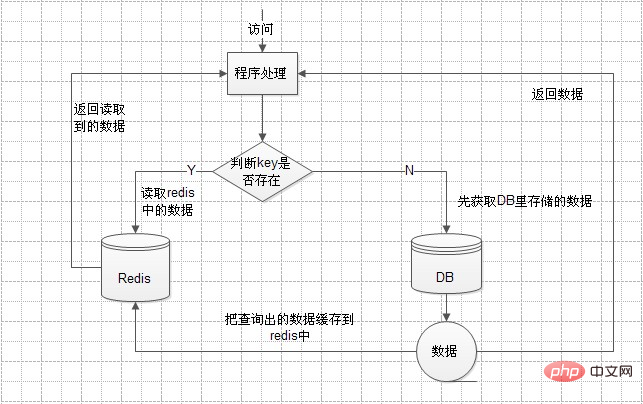Consistency between cached data and persistent data, this problem is summarized (I saw a good blog post), it is actually reading and writing, and there is also the issue of who comes first and who comes last. .

Theoretically, setting an expiration time for the cache is a solution to ensure eventual consistency. Under this solution, we can set the expiration time for the data stored in the cache. All write operations are subject to the database, and we only need to do our best for cache operations. (Recommended learning: Redis video tutorial)
That is to say, if the database write is successful and the cache update fails, then as long as the expiration time is reached, subsequent read requests will naturally read new values from the database and backfill the cache.
Redis is a high-performance key-value database. The emergence of redis has largely compensated for the shortcomings of key-value storage such as memcached, and can play a very good supplementary role to relational databases in some situations. It provides python, Ruby, Erlang, and PHP clients, which are very convenient to use.
According to our general scenario of using Redis, it should be like this:

In other words: we will go to redis first Determine whether the data exists. If it exists, return the cached data directly. If it does not exist, it will go to the database, read the data, and cache the data into Redis.
Applicable occasions: If the amount of data is relatively large, but it is not updated frequently (such as user rankings)
The use of the second type of Redis is completed with the first situation Different, please see the specific situation:

Here we will first go to redis to determine whether the data exists. If it exists, then directly update the corresponding data (this step The corresponding updated key will be recorded, for example, it will also be saved in redis. For example: the key is: save_update_keys [recorded with lpush list]), and the updated data will be returned to the page. If it does not exist, the content in the database will be updated first, and then a copy of the data will be saved in Redis.
NO10 Step: Later work: There will be relevant mechanisms in the background to read the keys stored in save_update_keys in Redis respectively, find the corresponding data, and update it to the DB.
Advantages: The main purpose of this process is to use Redis as a database, and updating and obtaining data is faster than DB. It is very suitable for frequent changes in large amounts of data (such as Weibo).
Disadvantages: It relies heavily on Redis, so it is necessary to save data during downtime. (However, you can use the snapshot AOF of redis. If you recover quickly, it should not have much impact, because even if Redis stops working, it will not affect subsequent data processing.)
Difficulty: planning the key in the early stage Format and storage type are important because they will affect whether the data can be synchronized to the DB.
The above is the detailed content of How to synchronize redis cache with database. For more information, please follow other related articles on the PHP Chinese website!
 Commonly used database software
Commonly used database software
 What are the in-memory databases?
What are the in-memory databases?
 Which one has faster reading speed, mongodb or redis?
Which one has faster reading speed, mongodb or redis?
 How to use redis as a cache server
How to use redis as a cache server
 How redis solves data consistency
How redis solves data consistency
 How do mysql and redis ensure double-write consistency?
How do mysql and redis ensure double-write consistency?
 What data does redis cache generally store?
What data does redis cache generally store?
 What are the 8 data types of redis
What are the 8 data types of redis